
Sciaenidae is a family of ray-finned fishes belonging to the order Acanthuriformes. They are commonly called drums or croakers in reference to the repetitive throbbing or drumming sounds they make. The family consists of about 293 to 298 species in about 66 or 67 genera.
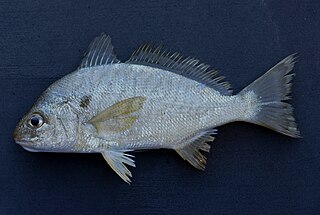
The spot, also known commonly as the spot croaker, Norfolk spot and the Virginia spot, is a species of small short-lived saltwater fish in the family Sciaenidae. The species inhabits estuary and coastal waters from Massachusetts to Texas, and derives its name from the prominent dark spot behind each gill. It is the only species in the genus Leiostomus. Spot are frequently caught by recreational anglers and are good to eat.
The striped croaker, also known as the St Lucian corvina, is a species of marine ray-finned fish belonging to the family Sciaenidae, the drums and croakers. This species is found in the western Atlantic Ocean in the Caribbean Sea and Gulf of Mexico.
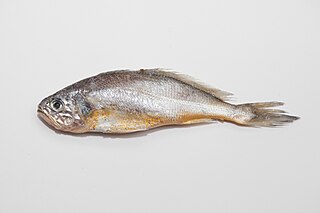
Larimichthys polyactis, called the redlip croaker, small yellow croaker, little yellow croaker or yellow corvina, is a species of croaker native to the western Pacific, generally in temperate waters such as the East China Sea and the Yellow Sea.

Larimichthys is a genus of marine ray-finned fishes belonging to the family Sciaenidae, the drums and croakers. These fishes, commonly known as yellow croakers, are found in the Western Pacific Ocean.

Nebris is a small genus of marine ray-finned fishes belonging to the family Sciaenidae, the drums and croakers. There are two species in the genus, one in the Western Atlantic Ocean and one in the Eastern Pacific Ocean.

Otolithes ruber, commonly known as the tigertooth croaker, silver teraglin, wiretooth, snapper kob, snapper salmon, Yankee whiting or Yankee salmon is a species of marine ray-finned fish belonging to the family Sciaenidae, the drums and croakers. This species is found in the Indo-Pacific region.
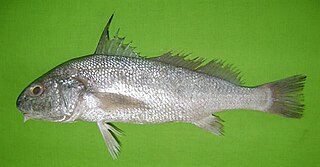
Johnius amblycephalus, the bearded croaker, also known as the green-backed croaker or sharp-nosed jewfish, is a marine ray-finned fish belonging to the family Sciaenidae, the drums and croakers. This fish is found in the Indian and Pacific Oceans.

Reeve's croaker, also known as the goldbelly croaker, golden corvina, yellowfin croaker or yellowfin corvina, is a species of marine ray-finned fish belonging to the family Sciaenidae, the drums and croakers. This species is found in the coastal waters of the Indo-Pacific region. It is the only species in the monospecific genus Chrysochir.

Odontoscion dentex, the reef croaker or brown large-eyed croaker, is a species of marine ray-finned fish belonging to the family Sciaenidae, the drums and croakers. It is found in coral and rocky reefs of the tropical Western Atlantic, living as solitary individuals or in small groups at a depth of 1 to 30 m. This species feeds on small fish, shrimp, and larvae.

The geelbeck croaker, also known as the African weakfish or Cape salmon, is a species of marine ray-finned fish belonging to the family Sciaenidae, the drums and croakers. This species is found in the southwestern Indian Ocean off southeastern Africa.
The yellowtail croaker, also known as the yellowtail jewfish, is a species of marine ray-finned fish belonging to the family Sciaenidae, the drums and croakers. This species is found in the southwestern Pacific Ocean off northern Australia and southern New Guinea. It is the only species in the monospecific genus Austronibea.

Cheilotrema is a genus of marine ray-finned fishes belonging to the family Sciaenidae, the drums and croakers. These fishes are found in the eastern Pacific Ocean.

Isopisthus is a genus of marine ray-finned fishes belonging to the family Sciaenidae, the drums and croakers. These fishes are found in the western Atlantic and eastern Pacific Oceans.

Johnius dussumieri, the sin croaker, Dussumier's croaker, Dussumier's silver jewfish, sharptooth hammer croaker or whiskered croaker, is a marine ray-finned fish belonging to the family Sciaenidae, the drums and croakers. This fish is found in the Indian Ocean.

Johnius carutta, the karut croaker or purple jewfish, is a species of marine ray-finned fish belonging to the family Sciaenidae, the drums and croakers. This species is found in the western Indian Ocean.
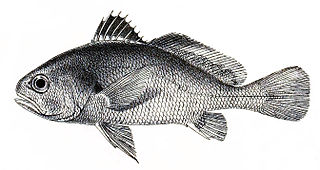
The kathala croaker is a species of marine ray-finned fish belonging to the family Sciaenidae, the drums and croakers. This species is found in the Indian Ocean off South Asia. It is the only species in the monospecific genus Kathala.
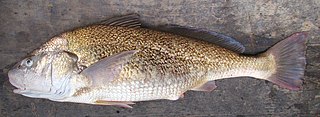
Micropogonias furnieri, the whitemouth croaker, golden croaker, hardhead, mangrove snapper, rocandoronco, two-belly bashaw, West Indian croaker, West Indian drum or whitemouth drummer, is a species of marine ray-finned fish belonging to the family Sciaenidae, the drums and croakers. This fish is found in the western Atlantic Ocean.

Odontoscion is a genus of marine ray-finned fish belonging to the family Sciaenidae, the croakers and drums. These fishes are found in the Western Atlantic and Eastern Pacific Oceans.

The half-mourning croaker is a species of marine ray-finned fish belonging to the family Sciaenidae, the drums and croakers. It is the only species in the monospecific genus Paranibea. This fish is found in the Indo-Pacific region.



















